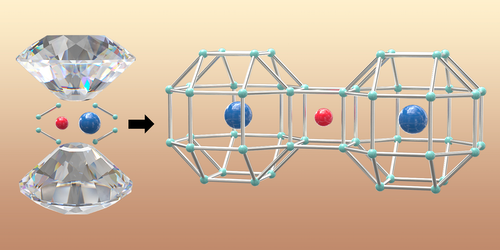Binary Superconductors, Meet Your Ternary Cousin
In the search for high-temperature superconductors, hydrogen-rich materials called superhydrides are leading contenders, with experiments showing they can remain superconducting up to around 250 K (–23 °C). To date, all the demonstrations of superconducting superhydrides have been on binary alloys—compounds that contain hydrogen and one other element. Now Guangtao Liu of Jilin University, China, and colleagues have measured superconductivity in the ternary hydride LaBeH8. The team finds that the material can superconduct at up to 110 K at a pressure of 80 gigapascals [1]. Ternary hydrides have a wider variety of structures than binary ones, Liu says, so, the demonstration could significantly expand the materials available for high-temperature superconductivity studies.
The chemical composition of a material is a key parameter in determining whether and up to what temperature it superconducts. Researchers have probed nearly all the possible binary hydrides and are searching for new systems with the goal of reaching higher superconducting temperatures. Models predict that there are 6 times more stable ternary hydrides than binary ones and that those materials could have high superconducting temperatures—even surpassing room temperature. But until now, researchers had only detected low-temperature superconductivity (below 7 K) in such a system.
Liu says that while the 110 K superconducting temperature the team measured in LaBeH8 is well below the maximum achieved for binary hydrides, the experiments are still an important proof of principle. “The experimental success encourages us to continue synthesizing other unexplored ternary hydrides with predicted high Tc values,” Liu says.
–Katherine Wright
Katherine Wright is the Deputy Editor of Physics Magazine.
References
- Y. Song et al., “Stoichiometric ternary superhydride LaBeH8 as a new template for high-temperature superconductivity at 110 K under 80 GPa,” Phys. Rev. Lett. 130, 266001 (2023).




